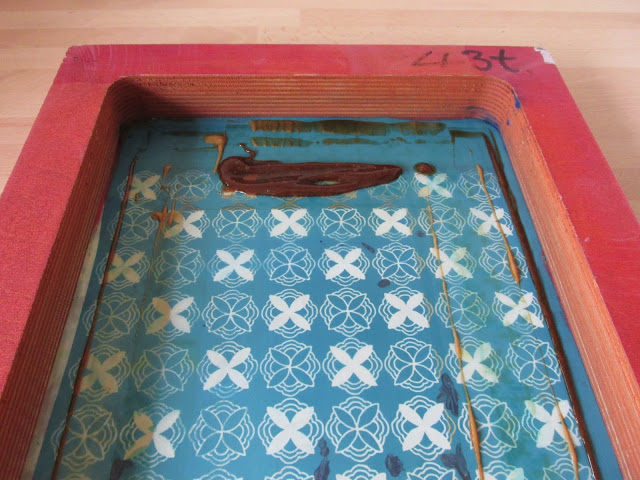I get many questions about the screen printing process and how it's done so I thought I would address some of those questions here on the blog.
Note that the answers are relevant to the processes that I do and each screen printer will/may have a different process to me.
1. What is Screen Printing
In short it's method of printing that uses mesh material wrapped around a frame, an image is burnt onto the mesh and using a squeegee ink is pushed through the mesh to print the image.
For a more detailed answer check out my other blog post:
http://helenjtaylordesign.blogspot.co.uk/2014/06/what-is-screen-printing.html
or you can check out some of the videos I have made on youtube:
https://www.youtube.com/channel/UCEj0z3-Ui22GvcJzgAGyIJA
2. What materials can you print onto?
I currently print onto any paper or card stock, fabric (cotton bags and t-shirts) and Plastic/Acrylic sheets.
3. What if I want to have something screen printed onto a material not mentioned?
Get in touch at helenprintdesign@gmail.com with a description of what the material is and I can see if it's possible.
4. Can you print onto rounded objects?
No because of the nature of the screens the material needs to flat or relatively flat to be able to print onto it.
5. Do you print using machines?
No I print everything by hand
6. What ink do you use?
Acrylic based ink and fabric ink (yes you need a different type of ink for fabric). In the case of printing onto plastic I use a Gloss Vinyl printing ink.
7. You use Photo Emulsion to screen print with, is that the only method?
No there are a range of different ways you do screen printing without the use of photo emulsion, for example you can use drawing liquid and screen filler to make your stencil or you can hand cut a stencil. Photo Emulsion is just my preferred method of screen printing.
8. Whats your maximum number and time frame for a print run?
On all the amounts mentioned below you must give at least 4 weeks notice before you need the products. This is to allow me to order in the materials, set up the equipment and print the run. any less I will not take on the job*.
Paper and Card - 500
Cotton Bags - 500
T-shirts - 100
Plastic/Acrylic - 50
*Only in exceptional circumstance will I print the run in short notice BUT even then I need 2 weeks notice.
9. What's your minimum number and time frame for a print run?
On the smaller runs I need at least 1-2 weeks notice before you need the items. This is to allow me to order in the materials, set up the equipment and print the run.
Paper and Card - 1
Cotton Bags - 5
T-shirts - 3
Plastic / Acrylic - 2
10. What if I need more than the maximum print run?
You will need to break the order up into smaller amounts
11. Why don't you print over these amounts?
Firstly the photo emulsion that I use on the screens will only last for so many prints before it starts to break up and I will start to lose the image.
Secondly I am working on my own and I print everything by hand (I don't have the luxury of a machine to do the printing). Also I can only store a certain amount of stock and printed items.
12. Why do I need to pay for Equipment set-up?
Each screen is set up using photo emulsion (which can be quite expensive), once the screen is coated I then need to turn your artwork into a stencil and print it of so it can be burnt onto the screen. The screen is then exposed using a halogen light for about 2 - 4 minutes. All this totals up to about a days worth of work before the printing has begun which means it needs to be paid for.
13. What Equipment do you use?
I use a silk screen, squeegee (to push the ink through), Ink and the material thats being printed.
14. Can you print all the colours at once?
If you want a colour gradient on the print then yes I print with more than one colour (this is called split fountain) otherwise no. I't not possible to print each colour at once as the colours will mix together and you will end up with one colour.
Printing more than one colour means that I print each colour once at a time, so for example if I was printing and image of a rainbow the red would be printed first and left to dry, then the yellow would be printed and left to dry and so on.
If you have any more questions make sure to leave them as a comment or you can send me and email with any queries.





















